Synergistic Effects of Propolis Combined with 2-Phenoxyethanol and Antipyretics on the Growth of Staphylococcus aureus
Abstract
1. Introduction
2. Materials and Methods
2.1. Chemicals and Reagents
2.2. Bacterial Strains and Media
2.3. Ethanol Extracts of Propolis and Polyphenols Mixture Preparation
2.4. Determination of Minimum Inhibitory Concentration and Minimum Bactericidal Concentration
2.5. Growth Curve
2.6. Checkerboard Dilution Test
2.7. Fractional Inhibitory Concentration (FIC) Index Calculation
2.8. Synergy Score Calculation
2.9. Data Analysis
3. Results
3.1. Antimicrobial Activity of Antipyretics and Antiseptics
3.2. In Vitro Evaluation of Combinations of Antipyretics and Antiseptics with Propolis Ethanolic Extracts
3.3. Antimicrobial Activity of Flavonoids of Propolis
4. Discussion
5. Conclusions
Author Contributions
Funding
Institutional Review Board Statement
Informed Consent Statement
Data Availability Statement
Acknowledgments
Conflicts of Interest
References
- van de Sande-Bruinsma, N.; Fo Wong, D.L. WHO European strategic action plan on antibiotic resistance: How to preserve antibiotics. J. Pediatr. Infect. Dis. 2014, 9, 127–134. [Google Scholar] [CrossRef]
- Fischbach, M.A.; Walsh, C.T. Antibiotics for emerging pathogens. Science 2009, 325, 1089–1093. [Google Scholar] [CrossRef]
- Lowy, F.D. Staphylococcus aureus Infections. N. Engl. J. Med. 1998, 339, 520–532. [Google Scholar] [CrossRef] [PubMed]
- Plata, K.; Rosato, A.E.; Węgrzyn, G. Staphylococcus aureus as an infectious agent: Overview of biochemistry and molecular genetics of its pathogenicity. Acta Biochim. Pol. 2009, 56, 597–612. [Google Scholar] [CrossRef] [PubMed]
- Mueller, E.; Haim, M.; Petnehazy, T.; Acham-Roschitz, B.; Trop, M. An innovative local treatment for staphylococcal scalded skin syndrome.Eur. J. Clin. Microbiol. Infect. Dis. 2010, 29, 893–897. [Google Scholar] [CrossRef] [PubMed]
- Kulhankova, K.; King, J.; Salgado-Pabon, W. Staphylococcal toxic shock syndrome: Superantigen-mediated enhancement of endotoxin shock and adaptive immune suppression. Immunol. Res. 2014, 59, 182–187. [Google Scholar] [CrossRef]
- Fisher, E.L.; Otto, M.; Cheung, G.Y.C. Basis of Virulence in Enterotoxin-Mediated Staphylococcal Food Poisoning. Front. Microbiol. 2018, 9, 436. [Google Scholar] [CrossRef]
- Wise, R. BSAC Working Party on The Urgent Need: Regenerating Antibacterial Drug Discovery and Development. The urgent need for new antibacterial agents. J. Antimicrob. Chemother. 2011, 66, 1939–1940. [Google Scholar] [CrossRef]
- Wink, M. Evolutionary advantage and molecular modes of action of multi-component mix-tures used in phytomedicine. Curr. Drug Metab. 2008, 9, 996–1009. [Google Scholar] [CrossRef]
- Wink, M. Modes of action of herbal medicines and plant secondary metabolites. Medicines 2015, 2, 251–286. [Google Scholar] [CrossRef] [PubMed]
- Szweda, P. Antimicrobial Activity of Honey. In Agricultural and Biological Sciences: Honey Analysis; InTech: London, UK, 2017; pp. 215–232. [Google Scholar]
- Szweda, P.; Kot, B. Bee Products and Essential Oils as Alternative Agents for Treatment of Infections Caused by S. aureus. In Frontiers in Staphylococcus aureus; InTech: London, UK, 2017. [Google Scholar]
- Huang, S.; Zhang, C.-P.; Wang, K.; Li, G.; Hu, F.-L. Recent Advances in the Chemical Composition of Propolis. Molecules 2014, 19, 19610–19632. [Google Scholar] [CrossRef]
- Kujumgiev, A.; Tsvetkova, I.; Serkedjieva, Y.; Bankova, V.; Christov, R.; Popov, S. Antibacterial, antifungal and antiviral activity of propolis of different geographic origin. J. Ethnopharmacol. 1999, 64, 235–240. [Google Scholar] [CrossRef]
- Popova, M.; Bankova, V.; Butovska, D.; Petkov, V.; Nikolova-Damyanova, B.; Sabatini, A.G.; Marcazzan, G.L.; Bogdanov, S. Validated Methods for the Quantification of Biologically Active Constituents of Poplar-type Propolis. Phytochem. Anal. 2004, 15, 235–240. [Google Scholar] [CrossRef]
- Wojtyczka, R.D.; Dziedzic, A.; Idzik, D.; Kepa, M.; Kubina, R.; Kabała-Dzik, A.; Smoleń-Dzirba, J.; Stojko, J.; Sajewicz, M.; Wasik, T.J. Susceptibility of Staphylococcus aureus clinical isolates to propolis extract alone or in combination with antimicrobial drugs. Molecules 2013, 18, 9623–9640. [Google Scholar] [CrossRef]
- Grecka, K.; Kuś, P.M.; Okińczyc, P.; Worobo, R.W.; Walkusz, J.; Szweda, P. The anti-staphylococcal potential of ethanolic Polish propolis extracts. Molecules 2019, 24, 1732. [Google Scholar] [CrossRef] [PubMed]
- Przybyłek, I.; Karpiński, T.M. Antibacterial Properties of Propolis. Molecules 2019, 24, 2047. [Google Scholar] [CrossRef]
- Grecka, K.; Xiong, Z.R.; Chen, H.; Pełka, K.; Worobo, R.W.; Szweda, P. Effect of Ethanol Extracts of Propolis (EEPs) against Staphylococcal Biofilm—Microscopic Studies. Pathogens 2020, 9, 646. [Google Scholar] [CrossRef] [PubMed]
- Haghdoost, N.S.; Salehi, T.Z.; Khosravi, A.; Sharifzadeh, A. Antifungal activity and influence of propolis against germ tube formation as a critical virulence attribute by clinical isolates of Candida albicans. J. Mycol. Méd. 2016, 26, 298–305. [Google Scholar] [CrossRef] [PubMed]
- Gucwa, K.; Kusznierewicz, B.; Milewski, S.; van Dijck, P.; Szweda, P. Antifungal Activity and Synergism with Azoles of Polish Propolis. Pathogens 2018, 7, 56. [Google Scholar] [CrossRef]
- Inui, S.; Hatano, A.; Yoshino, M.; Hosoya, T.; Shimamura, Y.; Masuda, S.; Ahn, M.-R.; Tazawa, S.; Araki, Y.; Kumazawa, S. Identification of the phenolic compounds contributing to antibacterial activity in ethanol extracts of Brazilian red propolis. Nat. Prod. Res. 2014, 28, 1293–1296. [Google Scholar] [CrossRef]
- Cushnie, T.P.T.; Lamb, A.J. Antimicrobial activity of flavonoids. Int. J. Antimicrob. Agents 2005, 26, 343–356. [Google Scholar] [CrossRef]
- Mirzoeva, O.K.; Grishanin, R.N.; Calder, P.C. Antimicrobial action of propolis and some of its components: The effects on growth, membrane potential and motility of bacteria. Microbiol. Res. 1997, 152, 239–246. [Google Scholar] [CrossRef]
- Al-Waili, N.; Al-Ghamdi, A.; Ansari, M.J.; Al-Attal, Y.; Salom, K. Synergistic effects of honey and propolis toward drug multi-resistant Staphylococcus Aureus, Escherichia coli and Candida Albicans isolates in single and polymicrobial cultures. Int. J. Med. Sci. 2012, 9, 793–800. [Google Scholar] [CrossRef]
- Scazzocchio, F.; D’Auria, F.D.; Alessandrini, D.; Pantanella, F. Multifactorial aspects of antimicrobial activity of propolis. Microbiol. Res. 2006, 161, 327–333. [Google Scholar] [CrossRef] [PubMed]
- Speciale, A.; Costanzo, R.; Puglisi, S.; Musumeci, R.; Catania, M.R.; Caccamo, F.; Iauk, L. Antibacterial activity of propolis and its active principles alone and in combination with macrolides, beta-lactams and fluoroquinolones against microorganisms responsible for respiratory infections. J. Chemother. 2006, 18, 164–171. [Google Scholar] [CrossRef] [PubMed]
- de Oliveira Orsi, R.; Maurício Sforcin, J.; Regina Cunha Funari, S.; Fernandes Junior, A.; Bankova, V. Synergistic effect of propolis and antibiotics on the Salmonella Typhi. Braz. J. Microbiol. 2006, 37, 108–112. [Google Scholar] [CrossRef]
- Fernandes Júnior, A.; Cristina Balestrin, E.; Elaine Cristina Betoni, J.; de Oliveira Orsi, R.; de Lourdes Ribeiro de Souza da Cunha, M.; Cezar Montelli, A. Propolis: Anti-Staphylococcus aureus activity and synergism with antimicrobial drugs. Mem. Inst. Oswaldo Cruz 2005, 100, 563–566. [Google Scholar] [CrossRef] [PubMed]
- Stepanović, S.; Antić, N.; Dakić, I.; Svabić-Vlahović, M. In vitro antimicrobial activity of propolis and synergism between propolis and antimicrobial drugs. Microbiol. Res. 2003, 158, 352–357. [Google Scholar] [CrossRef] [PubMed]
- Orsi, R.O.; Fernandes, A.; Bankova, V.; Sforcin, J.M. The effects of Brazilian and Bulgarian propolis in vitro against Salmonella Typhi and their synergism with antibiotics acting on the ribosome. Nat. Prod. Res. 2012, 26, 430–437. [Google Scholar] [CrossRef] [PubMed]
- Nostro, A.; Cellini, L.; di Bartolomeo, S.; Cannatelli, M.A.; di Campli, E.; Procopio, F.; Grande, R.; Marzio, L.; Alonzo, V. Effects of combining extracts (from propolis or Zingiber officinale) with clarithromycin on Helicobacter pylori. Phytother. Res. 2006, 20, 187–190. [Google Scholar] [CrossRef] [PubMed]
- Ong, T.H.; Chitra, E.; Ramamurthy, S.; Ling, C.C.S.; Ambu, S.P.; Davamani, F. Cationic chitosan-propolis nanoparticles alter the zeta potential of S. Epidermidis, inhibit biofilm formation by modulating gene expression and exhibit synergism with antibiotics. PLoS ONE 2019, 14, e0213079. [Google Scholar] [CrossRef]
- Vermeulen, H.; Westerbos, S.J.; Ubbink, D.T. Benefit and harm of iodine in wound care: A systematic review. J. Hosp. Infect. 2010, 76, 191–199. [Google Scholar] [CrossRef]
- Zimmermann, P.; Curtis, N. Antimicrobial Effects of Antipyretics. Antimicrob. Agents Chemother. 2017, 61. [Google Scholar] [CrossRef] [PubMed]
- Chan, E.W.L.; Yee, Z.Y.; Raja, I.; Yap, J.K.Y. Synergistic effect of non-steroidal anti-inflammatory drugs (NSAIDs) on antibacterial activity of cefuroxime and chloramphenicol against methicillin-resistant Staphylococcus aureus. J. Glob. Antimicrob. Resist. 2017, 10, 70–74. [Google Scholar] [CrossRef]
- Foerster, S.; Desilvestro, V.; Hathaway, L.J.; Althaus, C.L.; Unemo, M. A new rapid resazurin-based microdilution assay for antimicrobial susceptibility testing of Neisseria gonorrhoeae. J. Antimicrob. Chemother. 2017, 72, 1961–1968. [Google Scholar] [CrossRef]
- Odds, F.C. Synergy, antagonism, and what the chequerboard puts between them. J. Antimicrob. Chemother. 2003, 52, 1-1. [Google Scholar] [CrossRef]
- di Veroli, G.Y.; Fornari, C.; Wang, D.; Mollard, S.; Bramhall, J.L.; Richards, F.M.; Jodrell, D.I. Combenefit: An interactive platform for the analysis and visualization of drug combinations. Bioinformatics 2016, 32, 2866–2868. [Google Scholar] [CrossRef] [PubMed]
- Takaisi-Kikuni, N.; Schilcher, H. Electron Microscopic and Microcalorimetric Investigations of the Possible Mechanism of the Antibacterial Action of a Defined Propolis Provenance. Planta Med. 1994, 60, 222–227. [Google Scholar] [CrossRef]
- Bryan, J.; Redden, P.; Traba, C. The mechanism of action of Russian propolis ethanol extracts against two antibiotic-resistant biofilm-forming bacteria. Lett. Appl. Microbiol. 2016, 62, 192–198. [Google Scholar] [CrossRef] [PubMed]
- Castaldo, S.; Capasso, F. Propolis, an old remedy used in modern medicine. Fitoterapia 2002, 73, S1–S6. [Google Scholar] [CrossRef]
- Wang, T.; Li, Q.; Bi, K. Bioactive flavonoids in medicinal plants: Structure, activity and biological fate. Asian J. Pharm. Sci. 2018, 13, 12–23. [Google Scholar] [CrossRef]
- Ramadhan, F.; Mukarramah, L.; Oktavia, F.A.R.H.; Yulian, R.; Annisyah, N.H.; Asyiah, I.N. Flavonoids from endophytic bacteria of cosmos caudatus Kunth. Leaf as anticancer and antimicrobial. Asian J. Pharm. Clin. Res. 2018, 11, 200–204. [Google Scholar] [CrossRef][Green Version]
- Havsteen, B. Flavonoids, a class of natural products of high pharmacological potency. Biochem. Pharmacol. 1983, 32, 1141–1148. [Google Scholar] [CrossRef]
- Eagle, H.; Musselman, A.D. The rate of bactericidal action of penicillin in vitro as a function of its concentration, and its paradoxically reduced activity at high concentrations against certain organisms. J. Exp. Med. 1948, 88, 99–131. [Google Scholar] [CrossRef]
- Langsrud, S.; Steinhauer, K.; Lüthje, S.; Weber, K.; Goroncy-Bermes, P.; Holck, A.L. Ethylhexylglycerin Impairs Membrane Integrity and Enhances the Lethal Effect of Phenoxyethanol. PLoS ONE 2016, 11, e0165228. [Google Scholar] [CrossRef] [PubMed]
- Lim, K.-S.; Kam, P.C.A. Chlorhexidine-Pharmacology and Clinical Applications. Anaesth. Intensive Care 2008, 36, 502–512. [Google Scholar] [CrossRef]
- Hübner, N.-O.; Siebert, J.; Kramer, A. Octenidine Dihydrochloride, a Modern Antiseptic for Skin, Mucous Membranes and Wounds. Ski. Pharmacol. Physiol. 2010, 23, 244–258. [Google Scholar] [CrossRef] [PubMed]
- Obad, J.; Šušković, J.; Kos, B. Antimicrobial activity of ibuprofen: New perspectives on an “Old” non-antibiotic drug. Eur. J. Pharm. Sci. 2015, 71, 93–98. [Google Scholar] [CrossRef]
- Lee, C.-H.; Su, L.-H.; Liu, J.-W.; Chang, C.-C.; Chen, R.-F.; Yang, K.-D. Aspirin enhances opsonophagocytosis and is associated to a lower risk for Klebsiella pneumoniaeinvasive syndrome. BMC Infect. Dis. 2014, 14, 1–7. [Google Scholar] [CrossRef]
- Kalle, A.M.; Rizvi, A. Inhibition of Bacterial Multidrug Resistance by Celecoxib, a Cyclooxygenase-2 Inhibitor. Antimicrob. Agents Chemother. 2011, 55, 439–442. [Google Scholar] [CrossRef] [PubMed]
- Yin, Z.; Wang, Y.; Whittell, L.R.; Jergic, S.; Liu, M.; Harry, E.; Dixon, N.E.; Kelso, M.J.; Beck, J.L.; Oakley, A.J. DNA Replication Is the Target for the Antibacterial Effects of Nonsteroidal Anti-Inflammatory Drugs. Chem. Biol. 2014, 21, 481–487. [Google Scholar] [CrossRef]
- Hussein, A.; AL-Janabi, S. In Vitro antibacterial activity of ibuprofen and acetaminophen. J. Glob. Infect. Dis. 2010, 2, 105. [Google Scholar] [CrossRef] [PubMed]
- Gil, D.; Daffinee, K.; Friedman, R.; Bhushan, B.; Muratoglu, O.K.; LaPlante, K.; Oral, E. Synergistic antibacterial effects of analgesics and antibiotics against Staphylococcus aureus. Diagn. Microbiol. Infect. Dis. 2020, 96, 114967. [Google Scholar] [CrossRef]
- Altaf, M.; Ijaz, M.; Ghaffar, A.; Rehman, A.; Avais, M. Antibiotic susceptibility profile and synergistic effect of non-steroidal anti-inflammatory drugs on antibacterial activity of resistant antibiotics (Oxytetracycline and Gentamicin) against methicillin resistant Staphylococcus aureus (MRSA). Microb. Pathog. 2019, 137, 103755. [Google Scholar] [CrossRef] [PubMed]
- Pina-Vaz, C.; Sansonetty, F.; Rodrigues, A.G.; Martinez-DE-Oliveira, J.; Fonseca, A.F.; Mårdh, P.-A. Antifungal activity of ibuprofen alone and in combination with fluconazole against Candida species. J. Med. Microbiol. 2000, 49, 831–840. [Google Scholar] [CrossRef] [PubMed]
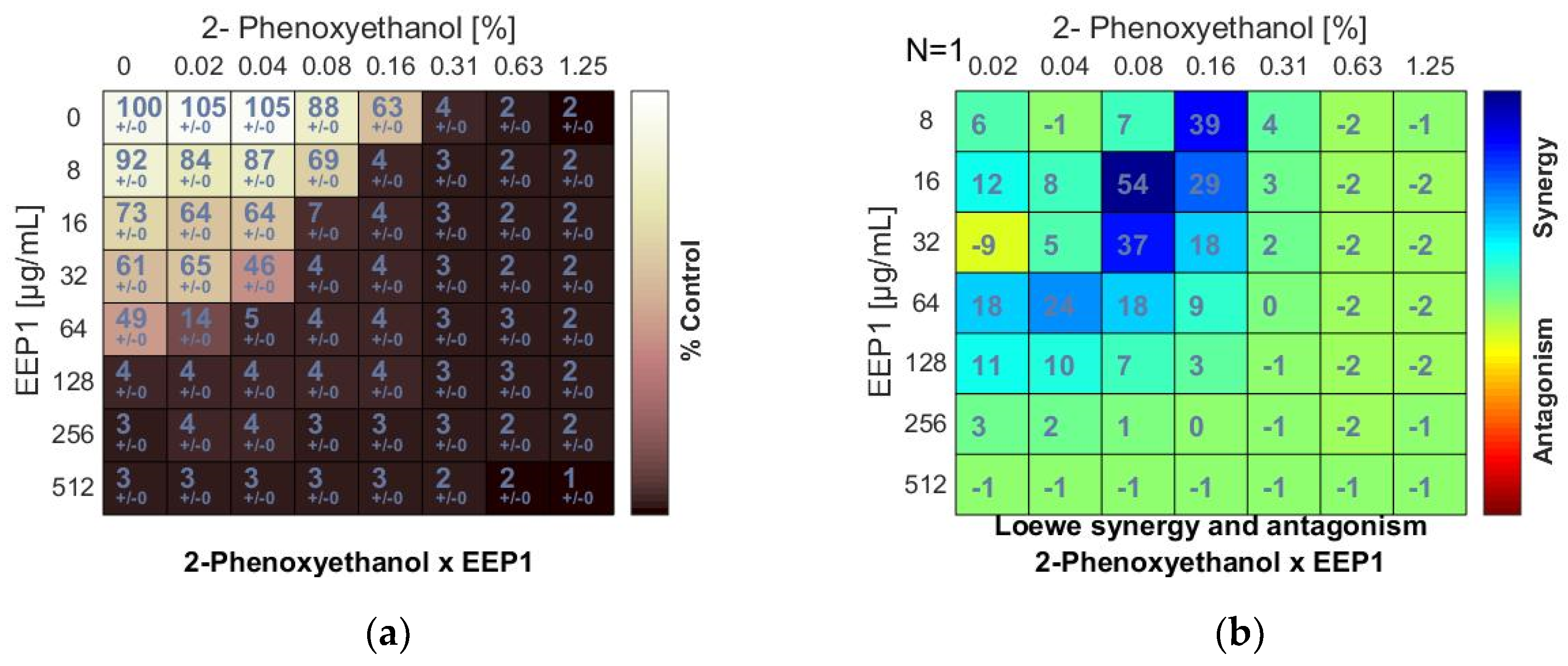
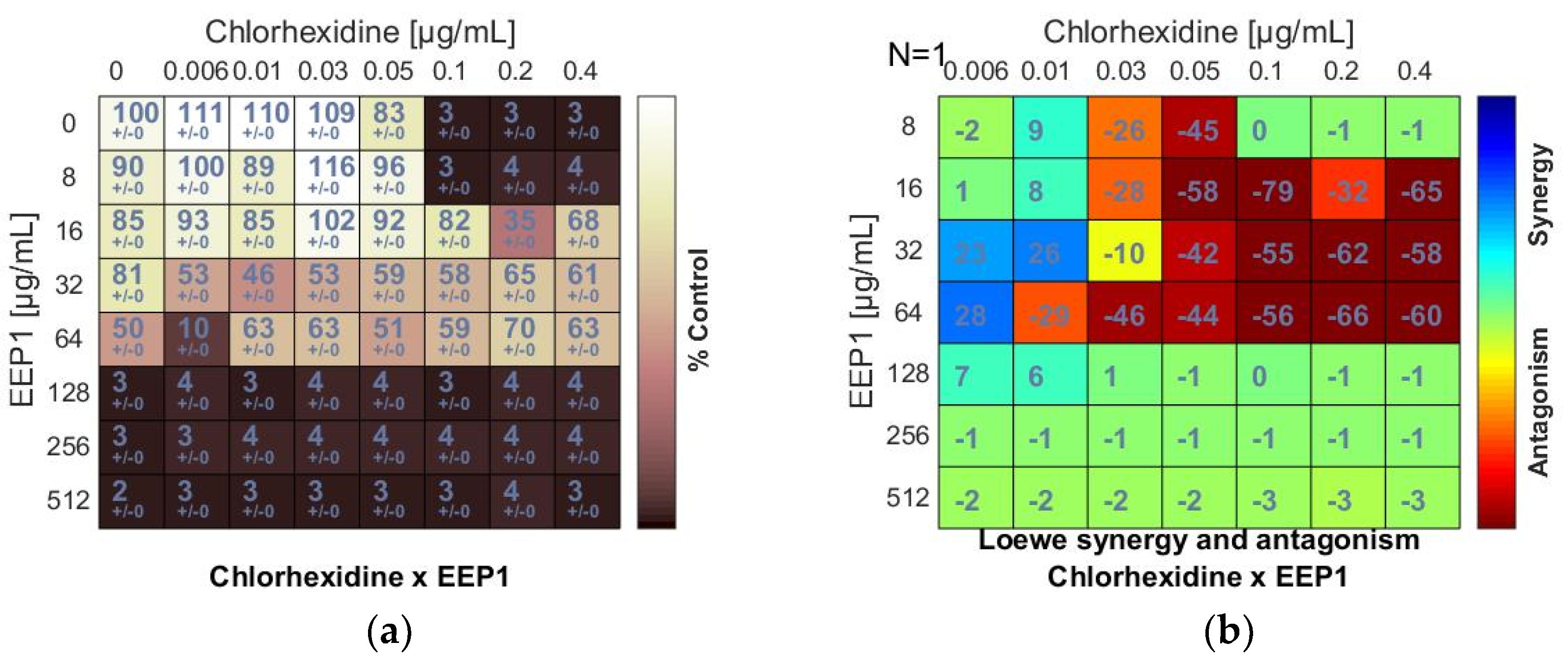
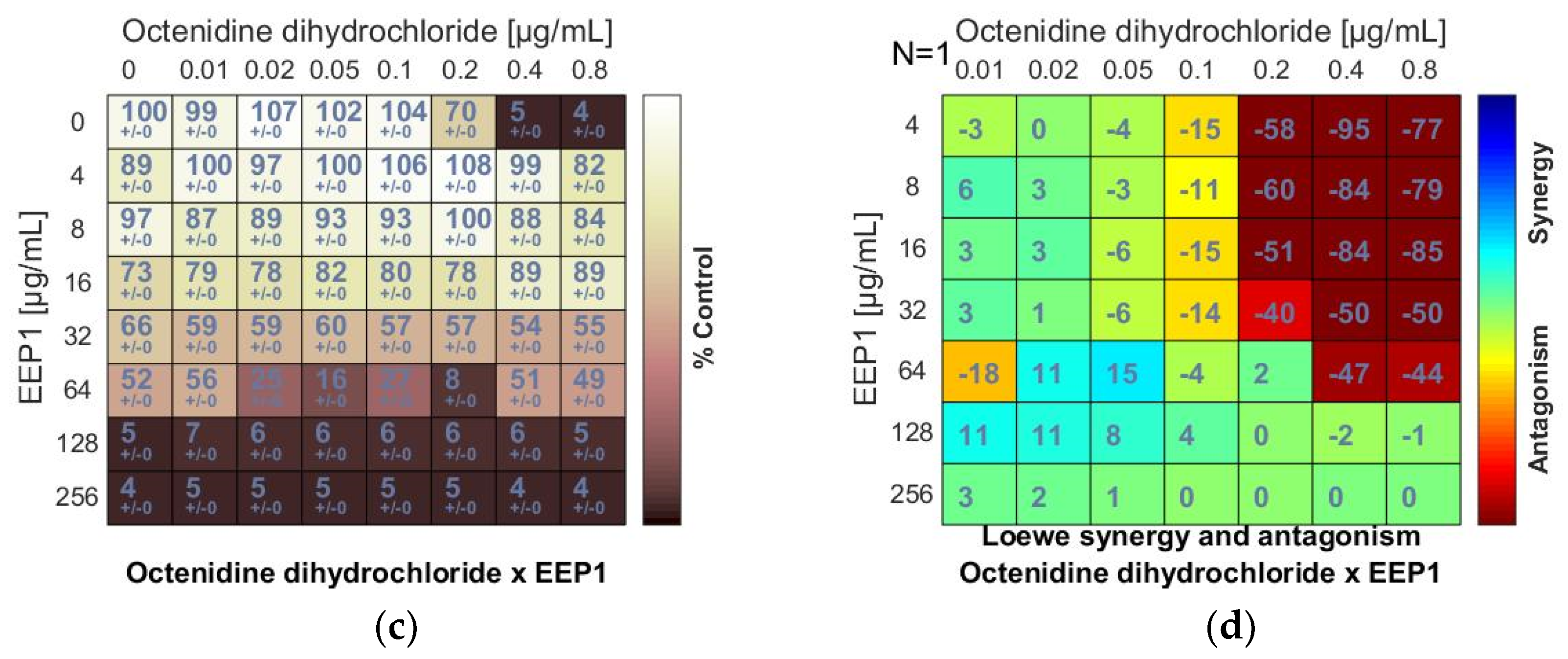
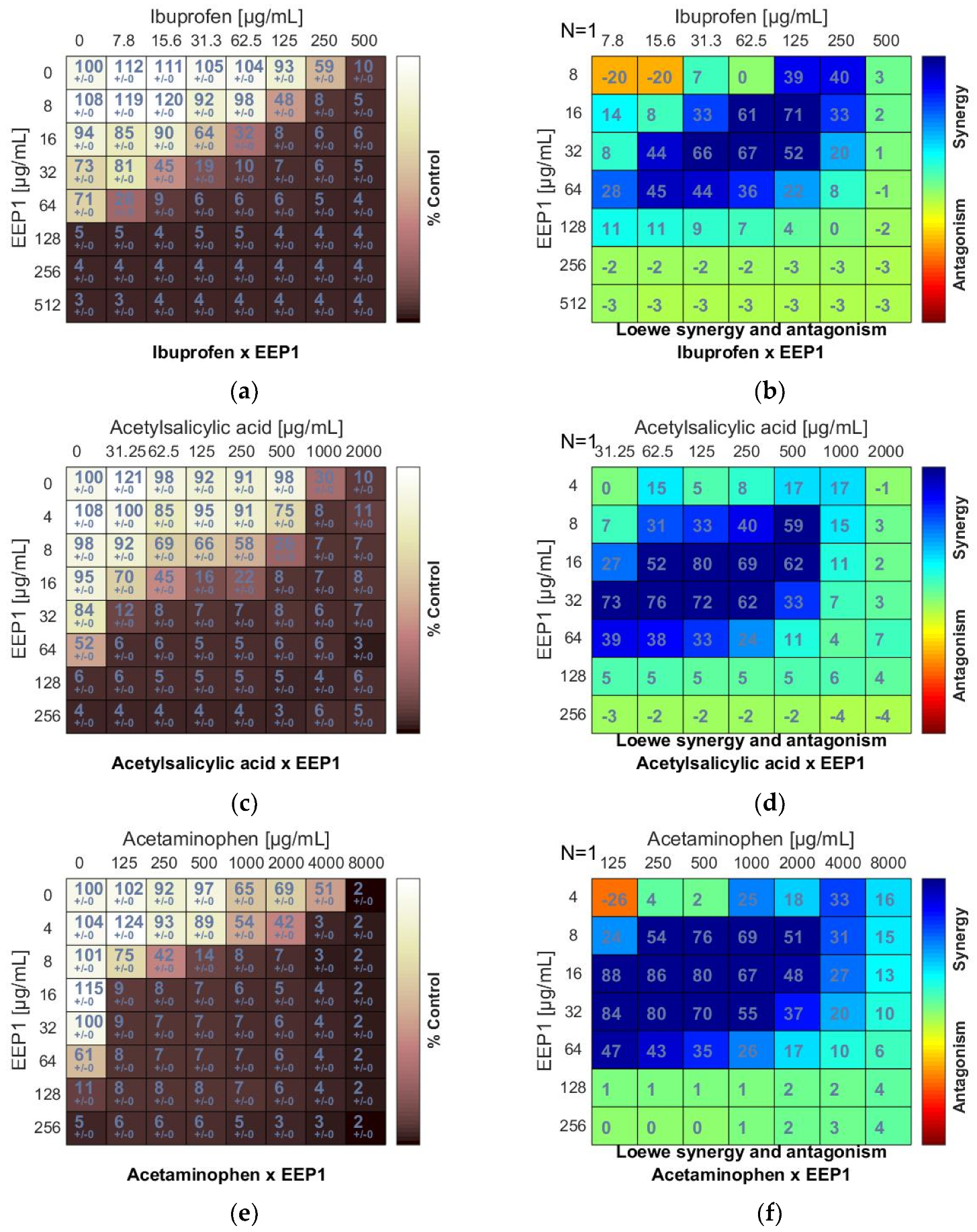
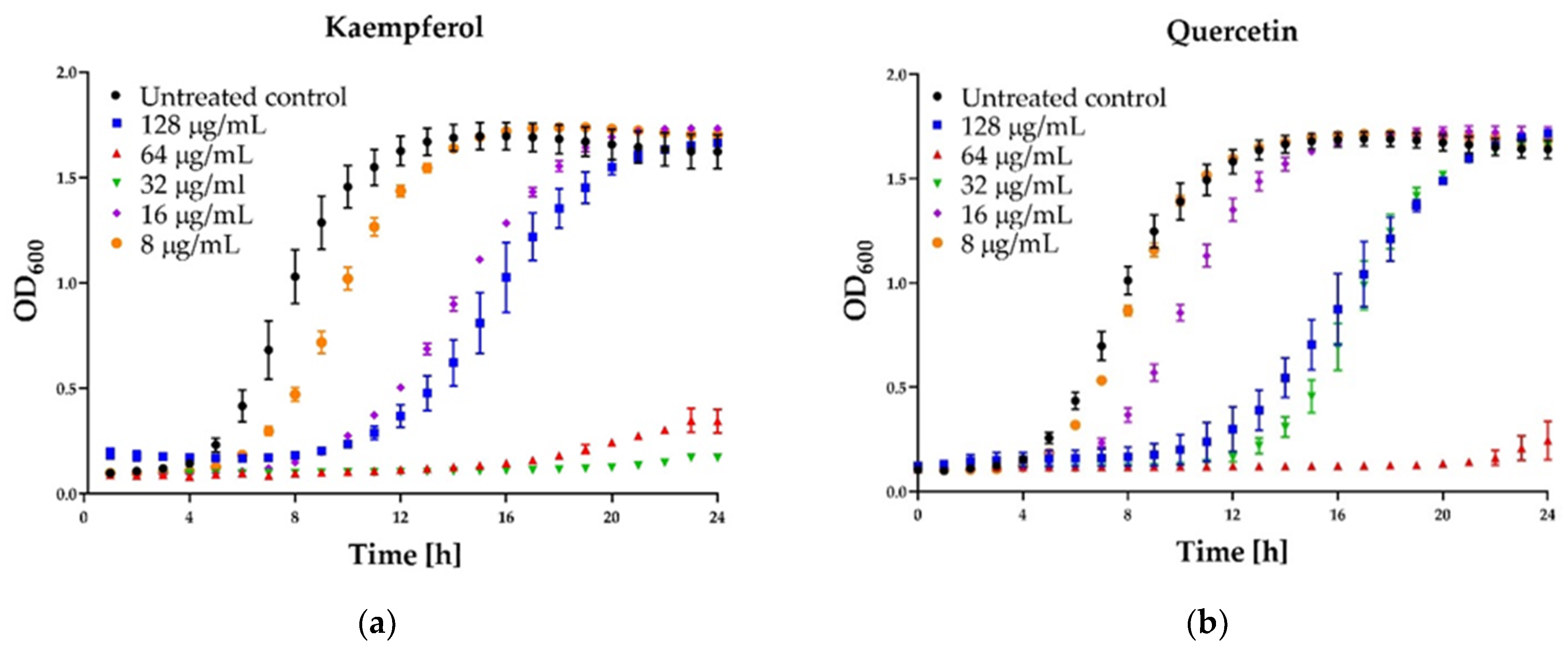
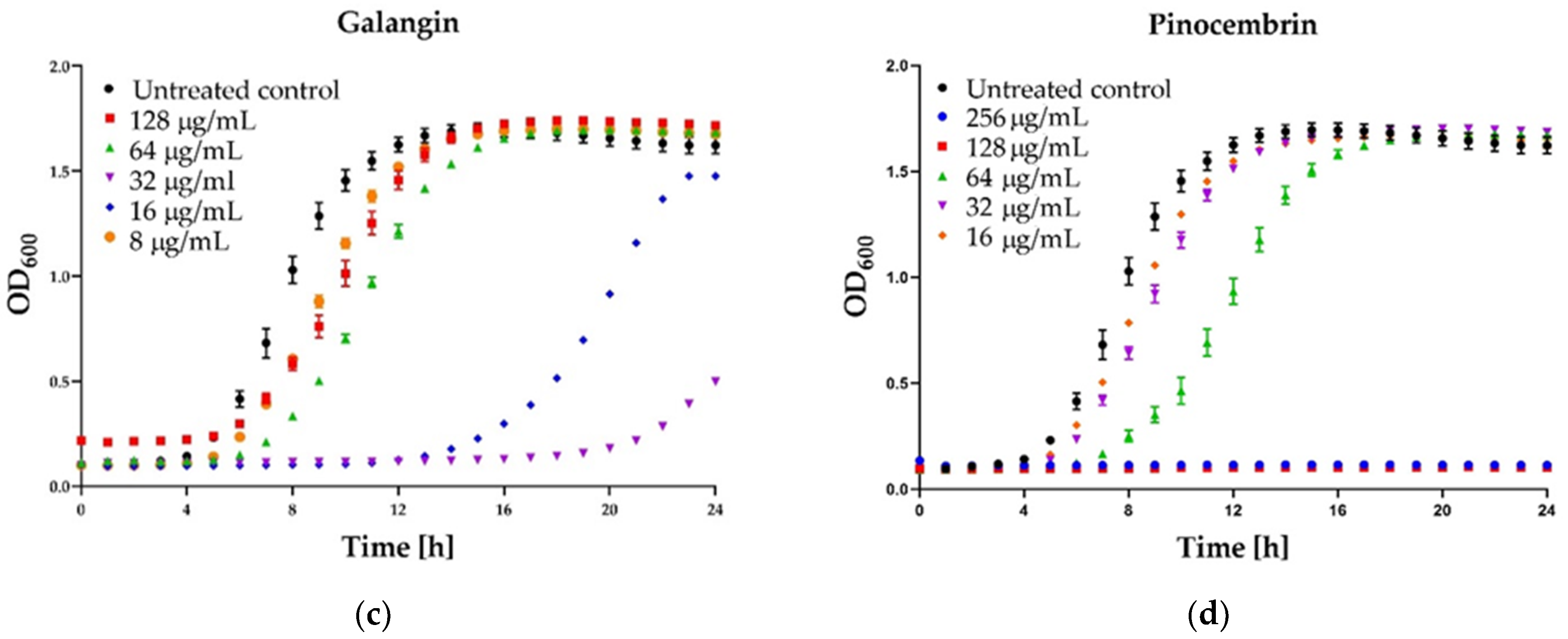
| Bacterial Strains | MIC and MBC Against Different Strains of Bacteria | |||||
|---|---|---|---|---|---|---|
| Acetaminophen (µg/mL) | Ibuprofen (µg/mL) | Acetylsalicylic Acid (µg/mL) | ||||
| MIC | MBC | MIC | MIC | MBC | MIC | |
| S. aureus ATCC 25923 | 8000 | >8000 | 500 | 4000 | 2000 | 4000 |
| S. aureus ATCC 29213 | >8000 | >8000 | 500 | 4000 | 2000 | 4000 |
| MSSA 1 | >8000 | >8000 | 500 | 2000 | 2000 | 4000 |
| MSSA 2 | 8000 | >8000 | 500 | 4000 | 1000 | 4000 |
| MSSA 3 | >8000 | >8000 | 500 | 4000 | 2000 | 4000 |
| MSSA 4 | >8000 | >8000 | 500 | 4000 | 1000 | 4000 |
| MSSA 5 | 8000 | >8000 | 500 | 4000 | 2000 | 4000 |
| MRSA 1 | 8000 | >8000 | 500 | 2000 | 2000 | 4000 |
| MRSA 2 | >8000 | >8000 | 500 | 2000 | 2000 | 4000 |
| MRSA 3 | 8000 | >8000 | 500 | 1000 | 2000 | 4000 |
| Bacterial Strains | MIC and MBC (µg/mL) against Different Strains of Bacteria | |||||
|---|---|---|---|---|---|---|
| 2-Phenoxyethanol (%(v/v)) | Chlorhexidine (µg/mL) | Octenidine Dihydrochloride (µg/mL) | ||||
| MIC | MBC | MIC | MBC | MIC | MBC | |
| S. aureus ATCC 25923 | 0.312 | 1.250 | 0.100 | 0.100 | 0.400 | 0.400 |
| S. aureus ATCC 29213 | 0.312 | 1.250 | 0.100 | 0.100 | 0.200 | 0.200 |
| MSSA 1 | 0.312 | 0.312 | 0.100 | 0.100 | 0.400 | 0.400 |
| MSSA 2 | 0.312 | 0.625 | 0.100 | 0.100 | 0.200 | 0.200 |
| MSSA 3 | 0.312 | 0.625 | 0.100 | 0.100 | 0.200 | 0.200 |
| MSSA 4 | 0.312 | 1.250 | 0.100 | 0.200 | 0.200 | 0.200 |
| MSSA 5 | 0.312 | 1.250 | 0.100 | 0.200 | 0.200 | 0.200 |
| MRSA 1 | 0.312 | 0.312 | 0.400 | 0.400 | 0.200 | 0.200 |
| MRSA 2 | 0.312 | 0.625 | 0.100 | 0.100 | 0.200 | 0.200 |
| MRSA 3 | 0.156 | 0.625 | 0.100 | 0.200 | 0.200 | 0.200 |
| Agent | MIC (µg/mL)/((%(v/v)) * | FIC | ΣFIC | Interpretation | |
|---|---|---|---|---|---|
| Alone | Combination | ||||
| EEP 1 | 128.000 | 16.000 | 0.125 | 0.375 | Synergy |
| PE | 0.312 | 0.080 | 0.250 | ||
| EEP 2 | 128.000 | 16.000 | 0.125 | 0.375 | Synergy |
| PE | 0.312 | 0.080 | 0.250 | ||
| EEP 3 | 256.000 | 16.000 | 0.063 | 0.187 | Synergy |
| PE | 0.312 | 0.040 | 0.125 | ||
| EEP 4 | 128.000 | 8.000 | 0.063 | 0.312 | Synergy |
| PE | 0.310 | 0.080 | 0.250 | ||
| EEP 1 | 128.000 | 128.000 | 1.000 | ≥9.000 | Antagonism |
| C | 0.100 | ≥0.800 | ≥8.000 | ||
| EEP 2 | 128.000 | 256.000 | 2.000 | ≥10.000 | Antagonism |
| C | 0.100 | ≥0.800 | ≥8.000 | ||
| EEP 3 | 256.000 | 256.000 | 1.000 | ≥9.000 | Antagonism |
| C | 0.100 | ≥0.800 | ≥8.000 | ||
| EEP 4 | 128.000 | 256.000 | 2.000 | ≥10.000 | Antagonism |
| C | 0.100 | ≥0.800 | ≥8.000 | ||
| EEP 1 | 128.000 | 128.000 | 1.000 | ≥5.000 | Antagonism |
| OD | 0.400 | ≥1.600 | ≥4.000 | ||
| EEP 2 | 128.000 | 128.000 | 1.000 | ≥5.000 | Antagonism |
| OD | 0.400 | ≥1.600 | ≥4.000 | ||
| EEP 3 | 256.000 | 512.000 | 2.000 | ≥6.000 | Antagonism |
| OD | 0.400 | ≥1.600 | ≥4.000 | ||
| EEP 4 | 128.000 | 64.000 | 0.500 | ≥4.500 | Antagonism |
| OD | 0.400 | ≥1.600 | ≥4.000 | ||
| Agent | MIC (µg/mL) | FIC | ΣFIC | Interpretation | |
|---|---|---|---|---|---|
| Alone | Combination | ||||
| EEP 1 | 128.000 | 16.000 | 0.125 | 0.375 | Synergy |
| IB | 500.000 | 125.000 | 0.250 | ||
| EEP 2 | 128.000 | 16.000 | 0.125 | 0.250 | Synergy |
| IB | 500.000 | 62.500 | 0.125 | ||
| EEP 3 | 256.000 | 32.000 | 0.125 | 0.187 | Synergy |
| IB | 500.000 | 31.300 | 0.062 | ||
| EEP 4 | 128.000 | 16.000 | 0.125 | 0.250 | Synergy |
| IB | 500.000 | 62.500 | 0.125 | ||
| EEP 1 | 128.000 | 16.000 | 0.125 | 0.250 | Synergy |
| AS | 2000.000 | 125.000 | 0.062 | ||
| EEP 2 | 128.000 | 32.000 | 0.250 | 0.281 | Synergy |
| AS | 2000.000 | 62.500 | 0.031 | ||
| EEP 3 | 256.000 | 16.000 | 0.062 | 0.078 | Synergy |
| AS | 2000.000 | 31.250 | 0.016 | ||
| EEP 4 | 128.000 | 8.000 | 0.062 | 0.125 | Synergy |
| AS | 2000.000 | 125.000 | 0.062 | ||
| EEP 1 | 128.000 | 16.000 | 0.125 | 0.141 | Synergy |
| AM | 8000.000 | 125.000 | 0.016 | ||
| EEP 2 | 128.000 | 8.000 | 0.062 | 0.094 | Synergy |
| AM | 8000.000 | 250.000 | 0.016 | ||
| EEP 3 | 256.000 | 64.000 | 0.250 | 0.312 | Synergy |
| AM | 8000.000 | 500.000 | 0.062 | ||
| EEP 4 | 128.000 | 8.000 | 0.062 | 0.094 | Synergy |
| AM | 8000.000 | 250.000 | 0.016 | ||
| Phenolic Compounds | MIC and MBC (µg/mL) against Different Strains of Bacteria | |||
|---|---|---|---|---|
| S. aureus ATCC 25923 | S. aureus ATCC 29213 | |||
| MIC | MBC | MIC | MBC | |
| Ferulic acid | >1024 | >1024 | >1024 | >1024 |
| Isoferulic acid | >1024 | >1024 | >1024 | >1024 |
| Caffeic acid | >1024 | >1024 | >1024 | >1024 |
| p-Coumaric acid | >1024 | >1024 | >1024 | >1024 |
| Apigenin | >1024 | >1024 | >1024 | >1024 |
| Chrysin | >1024 | >1024 | >1024 | >1024 |
| Quercetin | 64 | >1024 | 64 | >1024 |
| Kaempferol | 32 | >1024 | 32 | >1024 |
| Galangin | 32 | >1024 | 32 | >1024 |
| Pinocembrin | 128 | >1024 | 128 | 512 |
| Pinostrombin | >1024 | >1024 | >1024 | >1024 |
| Pinobanksin | 1024 | >1024 | 1024 | >1024 |
| Sakuranetin | 256 | >1024 | 256 | >1024 |
| Polyphenols mixture | 128 | 1024 | 128 | 256 |
| Phenolic Compounds | MIC/MBC | MIC and MBC (µg/mL) against Different Strains of Bacteria | |||||||
|---|---|---|---|---|---|---|---|---|---|
| MSSA 1 | MSSA 2 | MSSA 3 | MSSA 4 | MSSA 5 | MRSA 1 | MRSA 2 | MRSA 3 | ||
| Quercetin | MIC | 128 | 64 | 64 | 64 | 64 | 32 | 64 | 64 |
| MBC | >1024 | >1024 | >1024 | >1024 | >1024 | >1024 | >1024 | >1024 | |
| Kaempferol | MIC | >1024 | >1024 | >1024 | 32 | 32 | 32 | >1024 | >1024 |
| MBC | >1024 | >1024 | >1024 | >1024 | >1024 | >1024 | >1024 | >1024 | |
| Galangin | MIC | 64 | 32 | 32 | 32 | 32 | 32 | 32 | 32 |
| MBC | >1024 | >1024 | >1024 | >1024 | >1024 | >1024 | >1024 | >1024 | |
| Pinocembrin | MIC | 256 | 256 | 128 | 128 | 128 | 128 | 256 | 256 |
| MBC | >1024 | >1024 | >1024 | >1024 | >1024 | >1024 | >1024 | >1024 | |
| Pinobanksin | MIC | >1024 | >1024 | 1024 | 1024 | >1024 | 1024 | >1024 | >1024 |
| MBC | >1024 | >1024 | >1024 | >1024 | >1024 | >1024 | >1024 | >1024 | |
| Sakuranetin | MIC | 256 | 256 | 256 | 256 | 256 | 256 | 256 | 512 |
| MBC | >1024 | >1024 | >1024 | >1024 | >1024 | >1024 | >1024 | >1024 | |
| Polyphenols mixture | MIC | 256 | 128 | 128 | 128 | 128 | 32 | 128 | 128 |
| MBC | 1024 | 1024 | >1024 | 512 | 512 | 256 | 512 | 512 | |
Publisher’s Note: MDPI stays neutral with regard to jurisdictional claims in published maps and institutional affiliations. |
© 2021 by the authors. Licensee MDPI, Basel, Switzerland. This article is an open access article distributed under the terms and conditions of the Creative Commons Attribution (CC BY) license (http://creativecommons.org/licenses/by/4.0/).
Share and Cite
Grecka, K.; Szweda, P. Synergistic Effects of Propolis Combined with 2-Phenoxyethanol and Antipyretics on the Growth of Staphylococcus aureus. Pharmaceutics 2021, 13, 215. https://doi.org/10.3390/pharmaceutics13020215
Grecka K, Szweda P. Synergistic Effects of Propolis Combined with 2-Phenoxyethanol and Antipyretics on the Growth of Staphylococcus aureus. Pharmaceutics. 2021; 13(2):215. https://doi.org/10.3390/pharmaceutics13020215
Chicago/Turabian StyleGrecka, Katarzyna, and Piotr Szweda. 2021. "Synergistic Effects of Propolis Combined with 2-Phenoxyethanol and Antipyretics on the Growth of Staphylococcus aureus" Pharmaceutics 13, no. 2: 215. https://doi.org/10.3390/pharmaceutics13020215
APA StyleGrecka, K., & Szweda, P. (2021). Synergistic Effects of Propolis Combined with 2-Phenoxyethanol and Antipyretics on the Growth of Staphylococcus aureus. Pharmaceutics, 13(2), 215. https://doi.org/10.3390/pharmaceutics13020215






